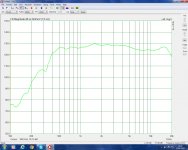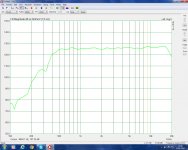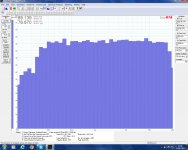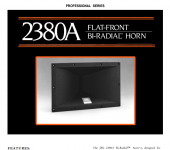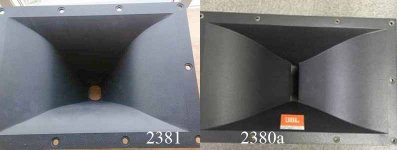I have probably read more guff on the "failings" of this horn than virtually any other! Most are from those using the proprietary JBL compression drivers, which I accept I have no experience of and I am guessing many have tried to attach a passive crossover which of course is a disaster waiting to happen. This is a "short throw" horn, meaningless of course but does infer a wide dispersion (90x40) and like the similar DDS, EV, Beyma variants is entirely appropriate for studio monitor as it is for live application depending on your choice of compression driver.
For a relatively low cost you can obtain DATs software impedance measuring device from Parts Express...and be prepared for a shock!! The impedance of horn/driver combinations as many are aware are unique to that pairing and complex. You will need series shunts, zobels and response correction and if you do not have a X-over simulation programme your chances of getting it right tend to zero. Small mistakes will lead to substantial peaks and troughs in the response.
Now if you are active the story is very different. I am posting a few images here of what this horn is capable of. All are with the Beyma 750Ti driver. Only taken "in room", on axis and with ARTA and True RTA. Gated was taken but was so similar to the pink noise I haven't shown it here. Obviously it revealed more small peaks and troughs but in terms of trend the responses were very similar. I set a 24dB/Oct LR filter at 200Hz just for driver protection.
Clearly this horn/driver is not capable over 16Khz but at my age not so relevant! Anyway some will add a tweeter and I believe a good operating range for this combination is going to be around 800Hz to 8KhZ (Active....analogue or DSP!). It is just possible to see on the plots the small response anomaly at 800Hz which coincided with the resonance of this driver. I have designed a series notch filter just to notch out this impedance spike but in truth -6dB down at 800Hz with an active (DSP) LR crossover and the effects will probably be minimal.
An interesting alternative, particularly for those that like the simplicity of a "two unit" system (certainly advantages to be had) is to fit the BMS coaxial 2" compression driver. This has an Fs of 300Hz for the midrange diaphragm (well below the horn cut off) and the coaxial tweeter section extend to 35Khz. Although I am not a fan of using horns near their cut off, I would suggest this may provide superb performance down to 500/600Hz?
Anyway ..here they are for the Beyma 750Ti/2380A..first is uncorrected, second and third are ARTA and True RTA versions corrected with a final extra hf tweak applied to the True RTA version. Ignore the "levels" shown on the plots as this aspect is not calibrated.
For a relatively low cost you can obtain DATs software impedance measuring device from Parts Express...and be prepared for a shock!! The impedance of horn/driver combinations as many are aware are unique to that pairing and complex. You will need series shunts, zobels and response correction and if you do not have a X-over simulation programme your chances of getting it right tend to zero. Small mistakes will lead to substantial peaks and troughs in the response.
Now if you are active the story is very different. I am posting a few images here of what this horn is capable of. All are with the Beyma 750Ti driver. Only taken "in room", on axis and with ARTA and True RTA. Gated was taken but was so similar to the pink noise I haven't shown it here. Obviously it revealed more small peaks and troughs but in terms of trend the responses were very similar. I set a 24dB/Oct LR filter at 200Hz just for driver protection.
Clearly this horn/driver is not capable over 16Khz but at my age not so relevant! Anyway some will add a tweeter and I believe a good operating range for this combination is going to be around 800Hz to 8KhZ (Active....analogue or DSP!). It is just possible to see on the plots the small response anomaly at 800Hz which coincided with the resonance of this driver. I have designed a series notch filter just to notch out this impedance spike but in truth -6dB down at 800Hz with an active (DSP) LR crossover and the effects will probably be minimal.
An interesting alternative, particularly for those that like the simplicity of a "two unit" system (certainly advantages to be had) is to fit the BMS coaxial 2" compression driver. This has an Fs of 300Hz for the midrange diaphragm (well below the horn cut off) and the coaxial tweeter section extend to 35Khz. Although I am not a fan of using horns near their cut off, I would suggest this may provide superb performance down to 500/600Hz?
Anyway ..here they are for the Beyma 750Ti/2380A..first is uncorrected, second and third are ARTA and True RTA versions corrected with a final extra hf tweak applied to the True RTA version. Ignore the "levels" shown on the plots as this aspect is not calibrated.
Attachments
Last edited:
Not sure what you mean...a "quack" would usually infer a response anomaly centred around 2/3khz. There is s peak here in the uncorrected plot which is easy to deal with. So do you mean a distorted sound...higher distortion due to the throat constriction/slot or does the response change at high spl?
I intend to include them in domestic/ studio environment where the spl in never going to exceed 110db from the whole system with most listening at much lower level.
I will set up ARTA and run a distortion plot and post that when I have the time...
I intend to include them in domestic/ studio environment where the spl in never going to exceed 110db from the whole system with most listening at much lower level.
I will set up ARTA and run a distortion plot and post that when I have the time...
The 'quack' is air overload in the throat, and as such is dynamic, not subject to a static measurement.
Just bringing the horn up to your mouth and talking into it will reveal this character.
Total BS
If there is overload in the throat then it would show up in a static measurement of distortion. If it were a slot reflection issue it would show up in frequency response. As response is a linear effect then we can effectively equalize it out (if it exists).
Somebodies been drinking the kool-aid.
David
This one here uses the same principle of horn - if not exactly the same type of horn:
— STRAUSS-ELECTROACOUSTICS.COM
I once had the opportunity to hear a pair of those in a studio. I didn't feel as if they were lacking in any way (well .... maybe price-wise but that is a different story).
Regards
Charles
— STRAUSS-ELECTROACOUSTICS.COM
I once had the opportunity to hear a pair of those in a studio. I didn't feel as if they were lacking in any way (well .... maybe price-wise but that is a different story).
Regards
Charles
looking at the pictures and the horns in my wall, it seems it's the same thing- if not exactly the same type of horn:
...and be prepared for a shock!! The impedance of horn/driver combinations as many are aware are unique to that pairing and complex. You will need series shunts, zobels and response correction and if you do not have a X-over simulation programme your chances of getting it right tend to zero. Small mistakes will lead to substantial peaks and troughs in the response.
Can you post some measurements without any EQ (ie Raw FR).
"Total BS"
Is this a 'well said for someone that cannot hear' moment?
Anyone living in the midwest is welcome to come over to my house and listen to horns and drivers, it is easy to hear the differences in just seconds.
I have horns and drivers spanning the last five or six decades.
If anyone hear can stand to listen to the modern style horns with narrow diffration slots, please let me know, I will make you a deal on any that I have.
Is this a 'well said for someone that cannot hear' moment?
Anyone living in the midwest is welcome to come over to my house and listen to horns and drivers, it is easy to hear the differences in just seconds.
I have horns and drivers spanning the last five or six decades.
If anyone hear can stand to listen to the modern style horns with narrow diffration slots, please let me know, I will make you a deal on any that I have.
I have probably read more guff on the "failings" of this horn than virtually any other!
Cheers for that. I bought a pair of the horns and those drivers last week.
I'll send some guff your way if they quack.
The newer JBL OA series 1.5" throat horns and drivers have about 10dB less distortion in the 8Khz region.
This is due to a higher cut-off frequency, and opening up the slot in the throat.
The narrow slot, long tail throat gives rise to a 'quacking' or 'frying bacon' sound at high volumes.
The air in the throat simply overloads.
A JBL 2380 can sound quite nasty at higher power levels, the EV HP940 sounds a bit better, but the HP640 sounds much, much better.
Why?
The slots on the wider dispersion horns are vertical, and as such are much narrower. The slot on the HP640 is in the horizontal plane and only diffracts in the vertical plane. To control for 40° vertical at 16Khz the slot only need be 1.56", so it is not 'squishing' the sound through a narrow slot and doesn't sound so compressed.
This is due to a higher cut-off frequency, and opening up the slot in the throat.
The narrow slot, long tail throat gives rise to a 'quacking' or 'frying bacon' sound at high volumes.
The air in the throat simply overloads.
A JBL 2380 can sound quite nasty at higher power levels, the EV HP940 sounds a bit better, but the HP640 sounds much, much better.
Why?
The slots on the wider dispersion horns are vertical, and as such are much narrower. The slot on the HP640 is in the horizontal plane and only diffracts in the vertical plane. To control for 40° vertical at 16Khz the slot only need be 1.56", so it is not 'squishing' the sound through a narrow slot and doesn't sound so compressed.
Last edited:
I'm running a pair of 2380A bi-radials on 2440 drivers, seems OK, I am using a tad of EQ with them. They may not be perfect but they seem a pretty significant improvement on the 2311/2308 combo I used before and a number of nameless exponential horns. (Edit: And I really like them!)
Michael..the first plot is without EQ! JBL published a paper on a test between the 2380, their larger 1.5" throat horn and the EV.
No horn is perfect! The 1.5" throat horn (which is discontinued) does indeed have lower distortion above 5KHz and smoother off axis response at lf (Larger horn!)
Having said that the distortion quoted by JBL on their original horn/driver combination does indeed reveal 10% 2nd harmonic above 5Khz with 10 watts in. I don't know about you but if the system is producing some 125dB at 5Khz you can imagine what the rest of the system is achieving. I don't sit 30 feet away in an audience when at home and don't listen at those levels. In fact, like most domestic or even studio listeners who might, just might (this is not the 70's anymore!) listen with peak levels of around 110dB from the whole system. The power fed to the horn then will be up to 1 watt and more likely in milliwatts?
Three other points! 2nd harmonic adds a richness (bit like a valve) and even at 10% is likely to be inaudible at these levels as your ears will be distorting more.
Modern drivers are much better designs regards phase plugs and path lengths. The Beyma seems to have an extraordinarily smooth and extended HF with nothing like the droop of earlier drivers. As a CD horn it still needs a 6dB shelf though.
It is not beyond the realms of a designer, particularly active, to add a tweeter above say 6k3...I find the Bob Crites T35 an excellent choice for very wide dispersion. Some may even choose the "coke tin" type from Fostex, Visaton, etc.
So there we have it, nothing is perfect in the world of horns. I like big ones, small ones, multicell ones but its "horses for courses". The point of the post is once again to highlight just sticking a passive network on an unequalised horn, (any horn) and drawing conclusions about it's sound quality is not a viable way forward!
But you can manage passive..if you must, and there is an argument I would suggest for a passive/active approach. Some horn/driver impedances are very complex and often have complex resonance right around the point you want to cross them over. I am tempted to attach an RCL network to flatten this and still cross them actively and achieve better driver damping through the likely crossover point. For instance the Beyma driver Fs is 830Hz and yet the recommended crossover is 800Hz! (Here's a tip!...for the Beyma 750Ti/2380A I made it 9.1Ohm/4.22mH/8.2mF (RCL)..still need FR correction of course))
For those that want to dabble cheaply but accurately...you will need the FRD curve, the ZMA plot and Xsim is fabulous! You could use the free version of ARTA and get SPL trace and plot manually (or "auto trace") or be nice and pay the man then you can save the FRD curve. DAT's is awesome and will give you the impedance curve, the TS parameters and will also measure caps, chokes and resisters.
And one last thing...if that is THE Nelson Pass (!)..I still have your Threshold Stasis S300 11, it's mint and still just one of the best amps I have ever heard!!! (bit of brown nosing right there!!)
No horn is perfect! The 1.5" throat horn (which is discontinued) does indeed have lower distortion above 5KHz and smoother off axis response at lf (Larger horn!)
Having said that the distortion quoted by JBL on their original horn/driver combination does indeed reveal 10% 2nd harmonic above 5Khz with 10 watts in. I don't know about you but if the system is producing some 125dB at 5Khz you can imagine what the rest of the system is achieving. I don't sit 30 feet away in an audience when at home and don't listen at those levels. In fact, like most domestic or even studio listeners who might, just might (this is not the 70's anymore!) listen with peak levels of around 110dB from the whole system. The power fed to the horn then will be up to 1 watt and more likely in milliwatts?
Three other points! 2nd harmonic adds a richness (bit like a valve) and even at 10% is likely to be inaudible at these levels as your ears will be distorting more.
Modern drivers are much better designs regards phase plugs and path lengths. The Beyma seems to have an extraordinarily smooth and extended HF with nothing like the droop of earlier drivers. As a CD horn it still needs a 6dB shelf though.
It is not beyond the realms of a designer, particularly active, to add a tweeter above say 6k3...I find the Bob Crites T35 an excellent choice for very wide dispersion. Some may even choose the "coke tin" type from Fostex, Visaton, etc.
So there we have it, nothing is perfect in the world of horns. I like big ones, small ones, multicell ones but its "horses for courses". The point of the post is once again to highlight just sticking a passive network on an unequalised horn, (any horn) and drawing conclusions about it's sound quality is not a viable way forward!
But you can manage passive..if you must, and there is an argument I would suggest for a passive/active approach. Some horn/driver impedances are very complex and often have complex resonance right around the point you want to cross them over. I am tempted to attach an RCL network to flatten this and still cross them actively and achieve better driver damping through the likely crossover point. For instance the Beyma driver Fs is 830Hz and yet the recommended crossover is 800Hz! (Here's a tip!...for the Beyma 750Ti/2380A I made it 9.1Ohm/4.22mH/8.2mF (RCL)..still need FR correction of course))
For those that want to dabble cheaply but accurately...you will need the FRD curve, the ZMA plot and Xsim is fabulous! You could use the free version of ARTA and get SPL trace and plot manually (or "auto trace") or be nice and pay the man then you can save the FRD curve. DAT's is awesome and will give you the impedance curve, the TS parameters and will also measure caps, chokes and resisters.
And one last thing...if that is THE Nelson Pass (!)..I still have your Threshold Stasis S300 11, it's mint and still just one of the best amps I have ever heard!!! (bit of brown nosing right there!!)
The newer JBL OA series 1.5" throat horns and drivers have about 10dB less distortion in the 8Khz region.
This is due to a higher cut-off frequency, and opening up the slot in the throat.
The lower distortion compared to older horns is due to a faster flare, and the 2380 already has a very fast flare.
http://www.jblpro.com/ProductAttachments/tn_v1n31.pdf
As can be seen page 8 the 2381 (1.5" version of the 2380) has less distortion than the square PT waveguide (which is deeper), and is said to have similar distortion to the rectangular PT waveguide.
- Status
- This old topic is closed. If you want to reopen this topic, contact a moderator using the "Report Post" button.
- Home
- Loudspeakers
- Multi-Way
- JBL2380A, myth busting!
